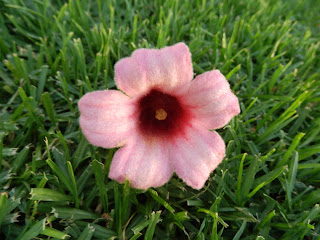We spent today at Naval Base, the little village of holiday homes where my Mother's family owns a few of the shacks that grace the cliff face of the Indian Ocean. In the current chain of days registering 40+ on the thermometer, it was a welcome respite, a chance to dip into the refreshing sea water before momentarily sunbathing in the heat of the midday sun.
Where Granddad's shack is, there is a tiny beach: a pocketful of sand hemmed in on one side by the rocky limestone cliffs and on the other by the pale aqua blue water rippling in the sunlight. For our first swim the water is calm and clear, quietly lapping at the golden sands allowing us to drift along following the striped fish and they darted in and out of the rocky outcrop below.
But midday a north-westerly breeze had hit, capping the growing waves and gently rocking us in the direction of the rocky shore. It then died down again, returning to a state of clear tranquillity and warmth, and tempted we submerged ourselves again, washing off the residual cobwebs of heat and sweat and stress.
Floating in the shallows, I remember a time, years ago, when as little girls my sister and I would float out to a rock ten metres from the shore and peering down through a glass-bottomed bucket, we would examine the sea grapes and mussels with which the rock abounded. It was from this selection that we would collect a sample to examine further at lunch. In addition to the fresh mussels, Naval Base brings with it memories of fresh crab, being taught to use the dead crab's claw to ferret out the tender flesh from the depths of the jointed legs. On one occasion a sea urchin was found, its life ending on the barbecue as like the mussels, it's shell was cracked open and content drained in high appreciation.
On occasion we would stay till dusk, watching rays play in the shallows, watching the sea breeze creep in, and the sea swell to a crescendo with the gradual setting of the sun.
Where Granddad's shack is, there is a tiny beach: a pocketful of sand hemmed in on one side by the rocky limestone cliffs and on the other by the pale aqua blue water rippling in the sunlight. For our first swim the water is calm and clear, quietly lapping at the golden sands allowing us to drift along following the striped fish and they darted in and out of the rocky outcrop below.
But midday a north-westerly breeze had hit, capping the growing waves and gently rocking us in the direction of the rocky shore. It then died down again, returning to a state of clear tranquillity and warmth, and tempted we submerged ourselves again, washing off the residual cobwebs of heat and sweat and stress.
Floating in the shallows, I remember a time, years ago, when as little girls my sister and I would float out to a rock ten metres from the shore and peering down through a glass-bottomed bucket, we would examine the sea grapes and mussels with which the rock abounded. It was from this selection that we would collect a sample to examine further at lunch. In addition to the fresh mussels, Naval Base brings with it memories of fresh crab, being taught to use the dead crab's claw to ferret out the tender flesh from the depths of the jointed legs. On one occasion a sea urchin was found, its life ending on the barbecue as like the mussels, it's shell was cracked open and content drained in high appreciation.
On occasion we would stay till dusk, watching rays play in the shallows, watching the sea breeze creep in, and the sea swell to a crescendo with the gradual setting of the sun.



















































